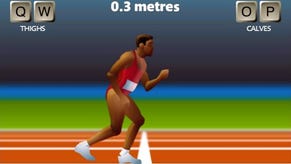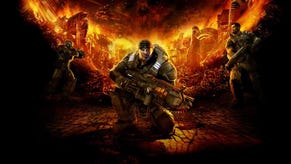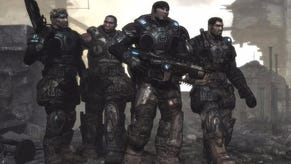Gears of War
Hands-on with the three multiplayer modes.
Glistening water laps at the harbour wall. A cool, clear light bathes a flight of dusty steps, picking out the baroque details of a portico above. A chainsaw passes through your abdomen and you explode in a shower of offal.
Gears of War's environments are lethally beguiling. But it's testament to how engrossing the gameplay is that it takes only a short few rounds before you start to ignore the staggering beauty and fidelity of the game-world, and instead see only opportunities for cover, defensible positions and ambush points. Speculations that the game would end up being GRAW In Space, however, are unwarranted. Although the game is tactical, there is also an immediacy to it, born of Gears' intuitive context-sensitive commands, that GRAW sometimes lacks. The A button becomes a multipurpose action button, enabling you to run in open spaces, to leap over obstacles, to dodge, roll and to dive into cover. That this button performs so many features, rather than having separate buttons for each command, is liberating, rather than restricting as you might imagine. This is probably due to Epic's careful anticipation of player needs. You want to leap from behind a pillar and roll into cover behind a chassis of a chewed-up car so you can blind-fire over it's bonnet - and lo, there is a context-sensitive option for you to do so. This, combined with the superb animation and the third-person camera, lends a cinematic quality to the fighting that is absent from many other games.
The subtleties of the game's level design, as well as the over-the-top weapons and copious gore, make it a much more confrontational experience than most tactical shooters, too. The levels tend towards medium-sized open areas linked by tight gauntlets - but even in the most expansive of maps, the amount of cover available meant that the majority of fire-fights were reasonably close quarters. During our time at Epic's studios in Raleigh, we managed to play ten levels - the shipping number recently confirmed by the developer. Cliff Bleszinski was cagey about whether or not subsequent content releases were to be free or not. Promisingly, however, he pointed to Epic's track record of releasing free additional content and intimated that this is the way he personally would like to go.
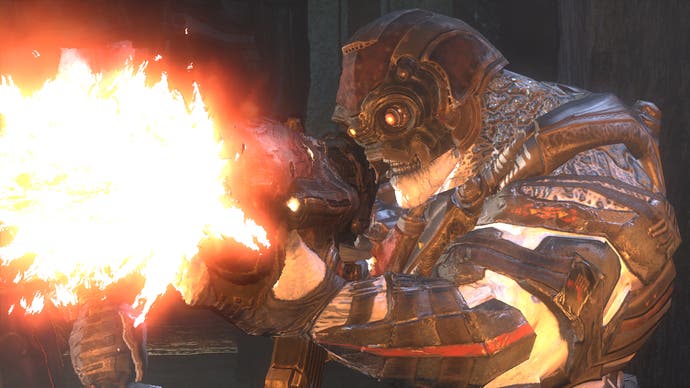
However, even the ten at launch are sure to offer you a decent level of diversity; aside from each being visually arresting in a unique way, several employ impressive set-pieces that help to vary the gameplay in significant ways. One level is fought on a sharp incline, creating interesting asymmetry - the advantage of the high ground mitigated by the sniper rifle spawn at the bottom. Another features a busy train-line, the crossing of which has to be timed pretty accurately lest you end up lubricating the tracks. A large gun emplacement dominates the centre-ground on a different level. It makes the match a mad dash for the centre, followed by a cat-and-mouse as players attacking the emplacement dart from cover to cover, trying to dislodge whoever is operating the gun. The tactics required to neutralise an entrenched opponent benefit from the way your health recharges - the indication of your near death is a bloody red circle in the centre of the screen which gradually fades as you recover. It's thus possible to approach the emplacement in stages, recovering from the gun's bombardment whilst in safety.
The amount of damage that players can take before going down falls somewhere between the extremes of realism - certainly more shots are required to make a kill than in most tactical shooters, but it takes less time to put someone down with the default assault rifle in Gears than with Halo's sub-machine gun, especially if you're aiming at the head. In all the multiplayer game modes, unless you are dismembered instantly, either by chainsaw, headshot or explosion, once you take enough damage you go "down but not out". In both normal team deathmatch and the Assassination game-type, your character is immobilised for a matter of seconds, after which he bleeds to death. This period can be extended by a frantic hammering of the A button, and during this time your team-mates can bring you back to full health by standing next to you and hitting X. Alternatively, your enemies can head-stomp you or chainsaw you or otherwise execute you in a number of grisly ways that unlock achievements. The Resurrection game-type changes this dynamic by automatically bringing downed players back to full health after this period of immobility expires. It sounds like a fairly negligible alteration but the affect on the game dynamic is marked - to actually kill an opponent you frequently have to get up close and personal, breaking cover to do so. Strange scenarios can arise in which you can use a downed team-mate to bait the execution-hungry opposition into ambush.
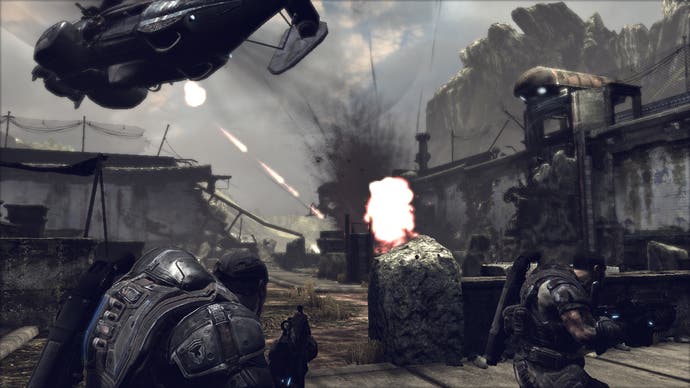
Similarly subtle is the way in which the Assassination game-type differentiates itself from the other two. The one player from each team with the most points becomes the leader, and it is only by killing either of these that the round ends. In a further twist, it is only the leader who can pick up any of the special weapons on the map. However, once he has picked up a weapon, and drops it in exchange for another, that weapon then becomes available to his team-mates. Outfitting the team in this way can consume time, and the trade-off between armaments and reaching defensible areas of the map, demands quick and keen decision-making over who gets what.
As for the weapons themselves, it seems the default kit has changed from that reported at X06. The default weapon is the iconic machine gun with chainsaw bayonet - hardly puny in itself. However, we were told that the chainsaw has been balanced since that event. Previously, it was possible to run into a hail of fire revving the chainsaw and still slice your enemy in half; now your sawing is interrupted by bullets, meaning that it becomes a weapon which requires you to flank your enemy or approach him from behind. You are also equipped with a shotgun which is capable of exploding someone entirely apart when at close range - an excellent means of repelling a chainsaw-wielding foe - a pistol with decent long-range accuracy, and some smoke grenades. The grenades, which are launched in a satisfying bolas style, can be aimed using the left trigger, which brings up a transparent arc showing you the trajectory they will take once fired. Other weapons are available as pick-ups, each with their own carefully balanced idiosyncrasies. As with previous Epic games, no weapon is substantially better across the board than any other, but rather there is a scissor-paper-stone interplay amongst their various strengths and weaknesses. The possible exception to this is the spectacular Hammer of God. Aiming it presents another transparent tracer, not unlike that of the grenades, and when fired, it calls down a satellite laser bombardment upon your target. However, even this does have its vulnerabilities: it operates in short bursts, is pretty localised, requires tricky positioning to aim accurately, and is ineffective against enemies who have cover above them.
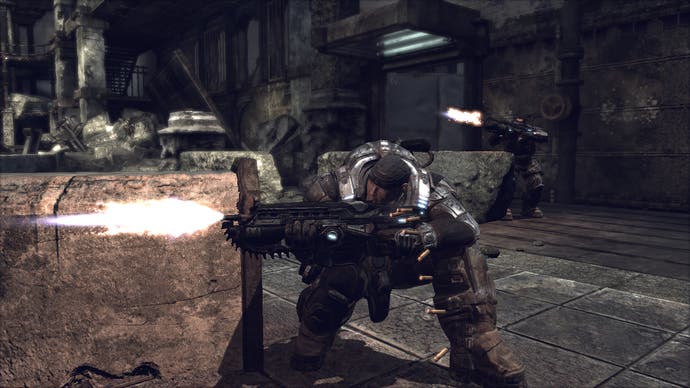
Amongst the other more unusual weapons is the Torque Bow, which acts a bit like the Wookie Bowcaster from the Jedi Knight games. Holding down the right trigger will power up the charge, which, when fired, explodes a few seconds after lodging into something (or someone). Frag grenades, too, can be stuck to an enemy, as can the smoke grenades. Although not at all deadly, having an enemy run about pluming smoke is rather amusing. Further weapons include a rapid-firing assault rifle, a slow-loading but lethal sniper rifle, and the Boom Shot. This last is essentially a rocket launcher, but its projectiles follow a gentle arc, which, as with the other weapons, can be previewed using the left-trigger's aiming mode.
The weapons' balance is emphasised in the teamplay dynamic that the game encourages. With a maximum of four per team, Epic seems to have hit a sweet spot in which a coordinated attack is of massive benefit, but being outnumbered does not present insurmountable odds. Quite frequently, a single player would be able to turn the tide of a match with a few judicious sneak-chainsawings. However, we found that by splitting a team into groups of two, and then having a one-up one-down configuration within each of these, we became a more effective fighting force. Surprisingly, such tactics came intuitively, rather than through any actual planning on our part. Having to cooperate closely with only one other person to have a successful game will no doubt be a boon in online gameplay, where the reliability of a whole team cannot be counted upon.
Generally, the impression of the game is that it is not one of great innovation, but one in which the features are implemented with brilliant cohesion. The graphics alone would make this a truly next-gen experience, but the superb balancing of gameplay elements means that this is more than just a pretty face.
Gears of War is due out exclusively for Xbox 360 on 17th November.

